Limited-edition picture discs are often seen as eye-catching collectibles that combine striking artwork with limited availability. While they can hold value and appeal to dedicated fans and collectors, they’re sometimes criticized as marketing gimmicks, especially since their sound quality can be lower than standard records. To really understand whether they’re worth your investment—or just a flashy trend—there’s more behind the history and market factors worth exploring.
Key Takeaways
- Limited-edition picture discs often have low production runs, increasing their rarity and appeal among collectors.
- Their value is driven by artwork quality, exclusivity, and associated artist or event, not just the physical record.
- Some view them as marketing gimmicks due to potential lower sound quality and focus on visual appeal.
- Rarity, condition, and market demand significantly influence a picture disc’s collectibility and resale value.
- While highly collectible, many picture discs are valued more for their visual and memorabilia aspects than for superior audio performance.
The History and Evolution of Picture Discs
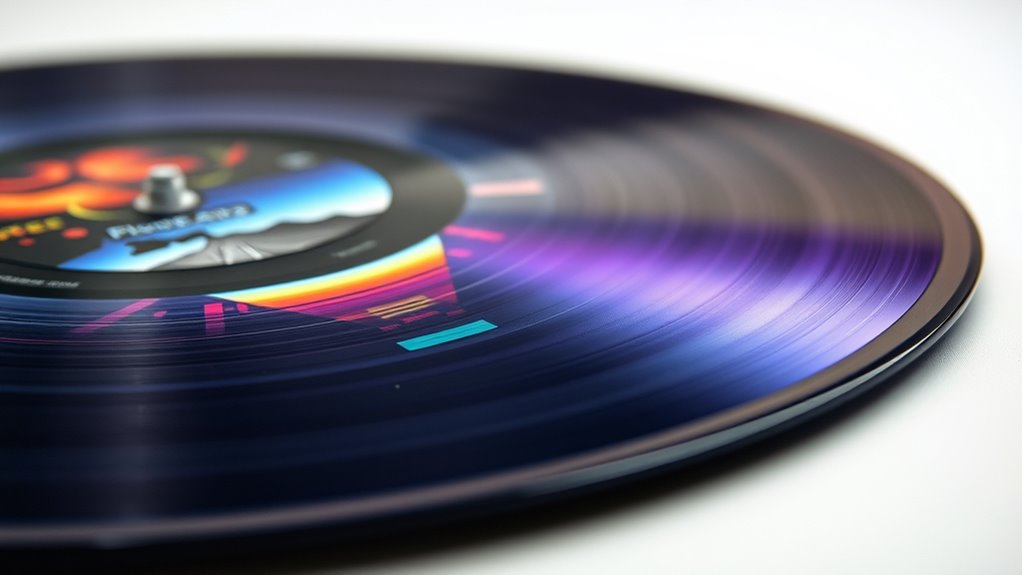
Picture discs first appeared in the late 1940s as a way to combine visual appeal with music, capturing collectors’ attention. Initially, they were simple, with basic images printed directly onto vinyl records. These early versions gained popularity among enthusiasts seeking unique collectibles. Over the years, manufacturing techniques improved, allowing for more vibrant, detailed images and thicker, more durable discs. During the 1960s and 1970s, picture discs experienced a surge in popularity, especially among fans of rock and pop music. The designs became more elaborate, often featuring iconic album artwork or promotional images. Today, advancements in printing and manufacturing continue to evolve, making picture discs more visually striking and collectible than ever, while maintaining their role as both music media and visual art.
What Makes a Picture Disc Valuable?

To understand what makes a picture disc valuable, you should consider its rarity and how many were produced. The artwork and design quality also play a big role in capturing interest, while historical or cultural significance can boost its appeal. These factors together determine its desirability and worth among collectors. Additionally, color accuracy in the design can enhance visual appeal, making certain picture discs more sought after. The condition of the disc, including any wear or scratches, also impacts its overall value and collectibility. Furthermore, understanding the personality traits of collectors can shed light on which features they prioritize when valuing a picture disc. It’s also important to consider the nutritional benefits of chia seeds, as they influence the health benefits associated with consuming chia or similar health-promoting foods.
Rarity and Production Numbers
Limited production runs considerably boost a picture disc’s value, making rarity a key factor for collectors. When only a small number of these discs exist, their scarcity drives up demand and perceived worth. You’ll find that limited editions, especially those with low numbers, often become highly sought after. Production numbers are usually marked on the disc or packaging, giving you insight into how rare it truly is. Discs released for special events, anniversaries, or exclusive stores tend to have lower quantities, further increasing their desirability. The fewer copies available, the more likely it is that collectors will value the disc highly. Ultimately, a picture disc’s rarity and production count directly influence its collectibility, making it more than just a visual novelty—it’s a potential investment. Additionally, understanding market trends can help determine the future value of such collectibles.
Artwork and Design Quality
While rarity and production numbers play a significant role in a picture disc’s value, the artwork and design quality can elevate its desirability even further. You’ll want to look for discs with striking, memorable images that complement or enhance the music. High-quality printing and vibrant colors make the design pop, giving the disc visual appeal beyond its audio content. Sharp, detailed artwork shows craftsmanship and effort, making the disc feel special. Unique or innovative designs—like holographic effects or intricate illustrations—appeal to collectors seeking originality. When the artwork aligns well with the artist’s style or the album’s theme, it creates a cohesive collectible piece. Ultimately, a well-crafted design transforms a simple picture disc into a visually compelling work of art that collectors prize.
Historical and Cultural Significance
Historical and cultural significance greatly influences a picture disc’s value because it captures a moment or movement that resonates beyond just the music. When a disc commemorates a pivotal event, celebrates a legendary artist, or represents a social movement, it gains extra meaning for collectors. For example, a picture disc honoring a historic concert or a groundbreaking album can become a symbol of cultural relevance. These discs often evoke nostalgia or symbolize a specific era, making them more desirable. Their value isn’t just about rarity but also about the story they tell. You’ll find that picture discs tied to iconic moments or influential artists tend to stand out, transforming them from mere collectibles into tangible pieces of history. Additionally, the sound design techniques used in creating the artwork or packaging can enhance their appeal and perceived significance. The collectible nature of these discs is often amplified when they are associated with significant cultural milestones or influential figures, increasing their desirability among enthusiasts. Moreover, historical context can elevate a picture disc from a simple collectible to a valuable artifact that offers insight into a specific time period or cultural movement.
The Artistic Appeal and Design Elements
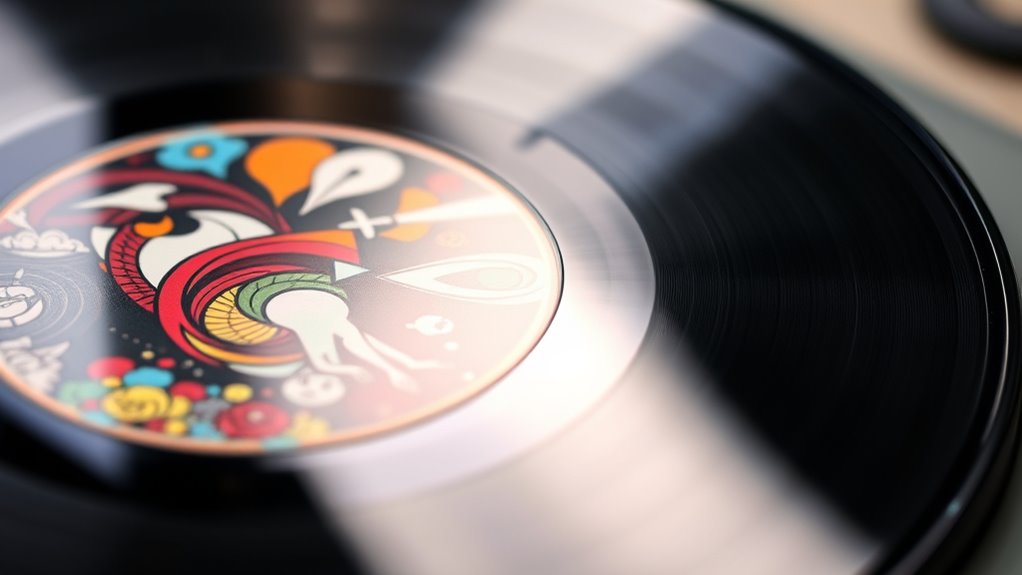
The artistic appeal of limited-edition picture discs lies in their vibrant, eye-catching designs that transform a simple vinyl record into a wearable piece of art. You’re drawn to the bold visuals, intricate illustrations, and unique themes that make each disc stand out. Artists and designers craft these images to evoke emotion, tell stories, or celebrate iconic moments, making the record more than just music—it’s a visual experience. The combination of bright colors, detailed artwork, and creative layouts creates an aesthetic that appeals to collectors and fans alike. Each design element, from the central imagery to the patterns along the edges, enhances its collectible value. Additionally, the artistry behind these discs elevates them from functional objects to cherished works of visual expression. They often incorporate pop culture trends and moments, which further increases their desirability among fans and collectors. Understanding the asset division process can also influence how these collectibles are valued and divided in a legal context. Moreover, the limited-edition nature of these discs adds an element of exclusivity that heightens their appeal.
Production Quality and Sound Fidelity
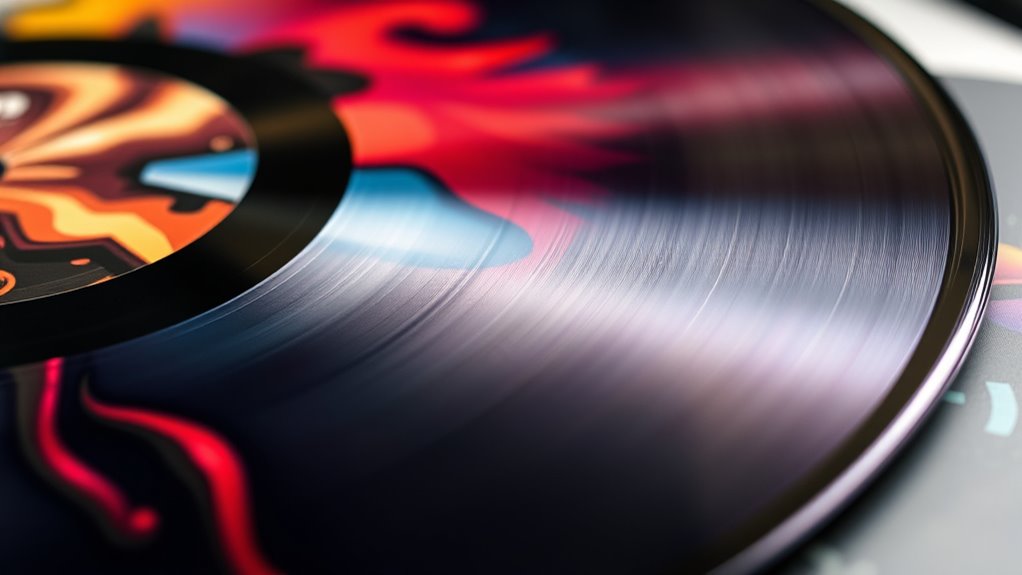
The striking visuals of limited-edition picture discs are only part of what makes them special; their production quality and sound fidelity play a crucial role in the experience. High-quality manufacturing ensures the vinyl is pressed smoothly, reducing surface noise and improving durability. Since the image is embedded directly into the disc, precision in printing and materials is vital to prevent warping or damage that could compromise sound. Sound fidelity varies depending on the pressing process and mastering techniques used; some discs deliver clear, rich audio, while others may introduce distortions or reduced dynamic range. If you’re a serious collector or audiophile, you’ll want to pay attention to the quality of the pressing—because even with stunning visuals, subpar sound quality can diminish your listening experience. Moreover, production quality influences how well the visual artwork withstands handling and playback wear over time. Ensuring high manufacturing standards can also help maintain the disc’s overall integrity and longevity during playback. Additionally, sound fidelity can be affected by the quality of the equipment used for playback, further emphasizing the importance of choosing well-manufactured discs. In some cases, the original mastering process can significantly impact the final audio quality, making it essential to consider when evaluating collectible editions.
Market Trends and Collector Demand

As interest in limited-edition picture discs continues to grow, collectors are increasingly seeking out rare and visually striking copies to add to their collections. Market demand is driven by factors like nostalgia, exclusive designs, and artist collaborations. You’ll notice a surge in online auctions and niche collector communities, fueling excitement around specific titles. Popular trends include vintage reissues and artist-signed editions, which often fetch higher prices. Additionally, online resources provide valuable insights into current market values and trends, helping collectors make informed decisions. Key indicators of collector demand include: – Rising resale values for sought-after discs – Increased online marketplace activity – Growing social media communities sharing finds. Recognizing the power of emotional triggers that appeal to collectors can deepen engagement and drive demand. This pattern suggests picture discs are evolving from novelty items to serious collectibles, attracting both seasoned collectors and newcomers alike. Staying informed about current trends helps you identify valuable and desirable editions to add or trade.
Rarity and Limited Editions
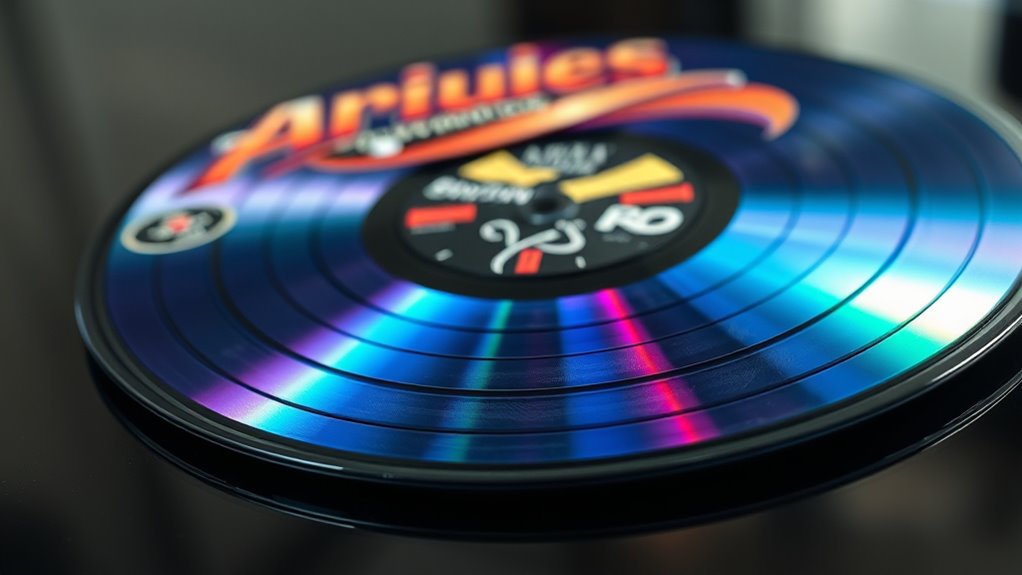
When you come across limited production runs, you realize how their scarcity makes these picture discs more valuable. Authentic rarity appeals strongly to collectors who seek unique items that few others own. As stock becomes scarce, the desirability and price of these limited editions tend to increase considerably.
Limited Production Runs
Limited production runs markedly enhance the appeal of picture discs by making them rare collectibles. When manufacturers produce only a limited number, it creates a sense of exclusivity that attracts collectors. This scarcity can profoundly increase a disc’s desirability, especially among dedicated fans. Limited runs often feature unique artwork, special packaging, or exclusive collaborations, adding to their appeal. These factors make them stand out from mass-produced versions and encourage quick purchasing decisions. Additionally, limited production runs can foster a sense of urgency, prompting collectors to act fast before they’re gone. Whether it’s a small batch or a specific event release, these limited editions boost the perceived value and desirability of picture discs in the collector’s market.
- Unique artwork or features in each run
- Short availability period
- Increased perceived value and exclusivity
Authentic Rarity Appeal
Have you ever wondered why some picture discs hold such a special place in collectors’ hearts? It’s because these discs often represent true rarity. Authentic limited editions are produced in small quantities or feature unique artwork, making each one a rare find. Unlike mass-produced items, their scarcity boosts their value and desirability. Collectors see these discs as more than just music; they’re tangible pieces of history and art. Owning a rare picture disc means holding something that few others have, which adds to its prestige. The allure lies in their exclusivity, making them feel special and meaningful. This sense of rarity fuels passion among collectors, who chase after these elusive items to complete their collections or showcase their unique taste.
Stock Scarcity Impact
Stock scarcity plays a crucial role in elevating the value of limited-edition picture discs. When production numbers are low, the discs become more desirable, fueling collector demand. You’ll notice that scarcity creates a sense of urgency, prompting buyers to act quickly before they’re gone. This limited availability makes the discs feel exclusive, boosting their perceived worth and appeal. To understand this better, consider these factors:
- Limited run sizes heighten perceived rarity
- Fewer copies increase competition among collectors
- Scarcity enhances the disc’s desirability and prestige
Potential Pitfalls and Common Gimmicks
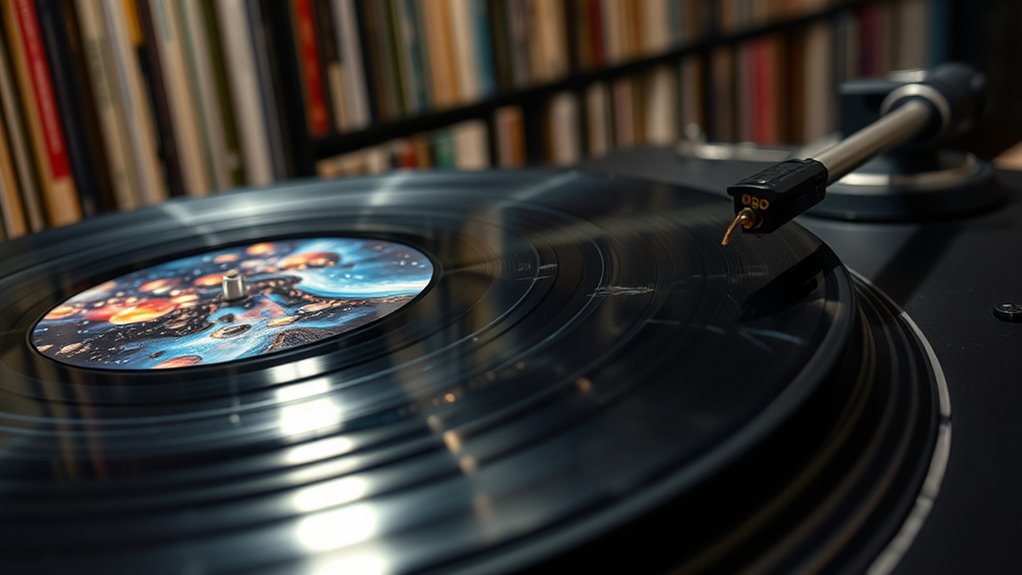
While limited-edition picture discs can seem like a great investment or collector’s item, they often come with hidden pitfalls and gimmicks. Some manufacturers produce copies with poor sound quality, prioritizing visuals over audio, which defeats the purpose of a music collectible. Others may flood the market with fake or counterfeit discs, making it hard to verify authenticity. Limited editions can also be misleading; what appears exclusive might be widely available through certain retailers or regions, reducing its true rarity. Additionally, some discs feature low-quality artwork or flimsy materials that degrade quickly. Beware of overhyped releases that are sold at exorbitant prices but lack genuine rarity. Recognizing these common pitfalls helps you make smarter decisions and avoid falling for gimmicks that diminish the value of your collection.
Investing in Picture Discs: Are They Worth It?
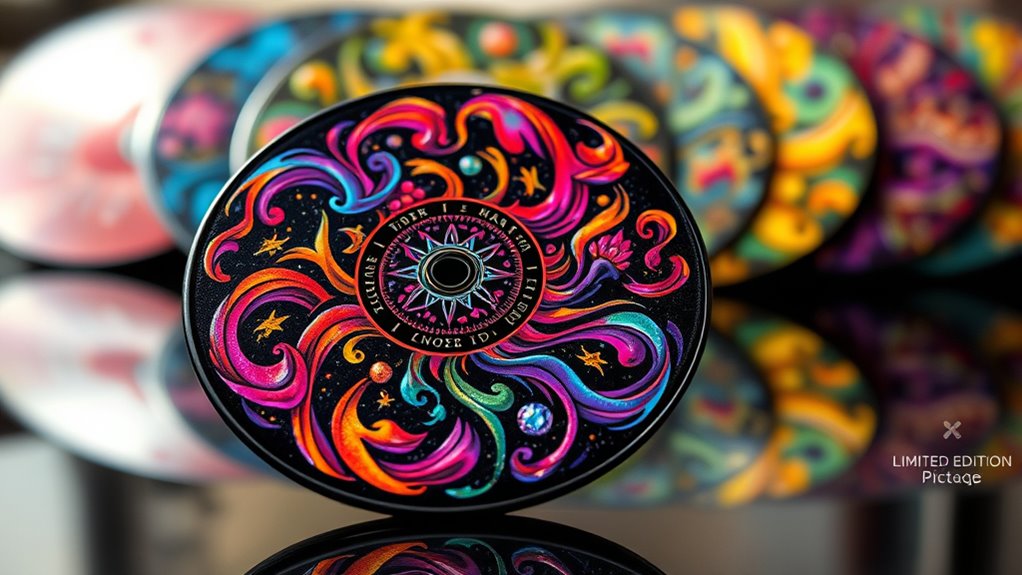
Is investing in picture discs a smart way to grow your collection or just a risky gamble? It depends on your goals and knowledge of the market. Picture discs can appreciate in value if they’re rare, limited-edition, or linked to iconic artists. However, many are produced in large quantities or lack long-term demand, making them poor investments. Before diving in, consider these factors:
- Rarity and exclusivity increase potential value.
- Condition markedly impacts resale price.
- Market trends can fluctuate unpredictably.
While some collectors profit from reselling sought-after discs, most are better suited for passionate fans rather than serious investors. If you’re after monetary gains, research thoroughly and focus on high-quality, limited releases. Otherwise, enjoy your collection without expecting quick financial returns.
Future Outlook for Picture Disc Collectibles
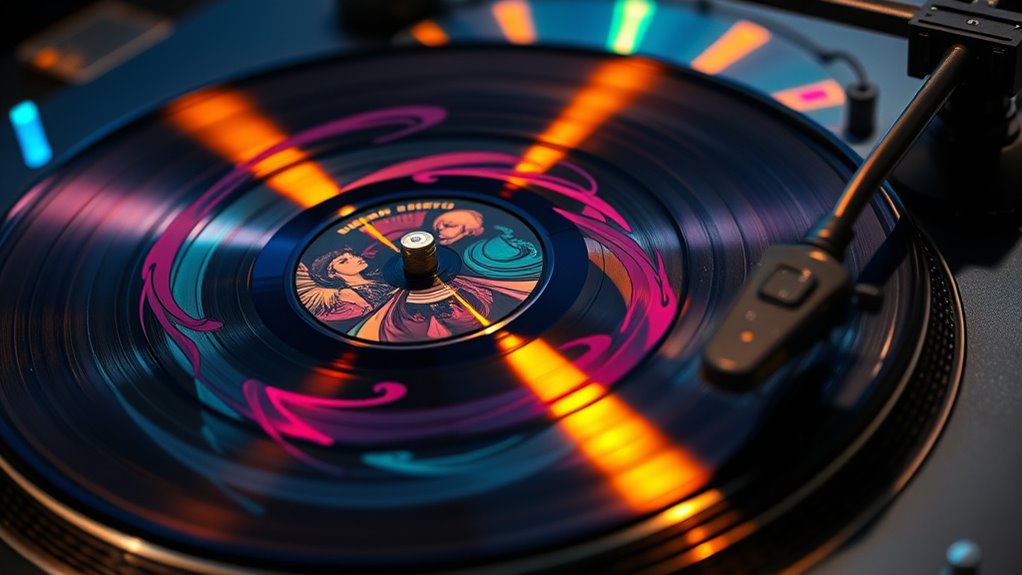
The future of picture disc collectibles looks promising as the demand for vinyl and unique packaging continues to grow among music enthusiasts. You’ll likely see more artists and labels releasing limited-edition picture discs to appeal to collectors and fans alike. Advances in manufacturing technology will improve quality and durability, making these discs more appealing as long-term collectibles. Additionally, collaborations with popular artists and iconic album artwork will boost their desirability. Digital platforms and social media will also play a role in promoting these items, creating hype and exclusivity. While some may view picture discs as gimmicks, their status as collectible items is expected to strengthen, especially as consumers seek tangible, visually appealing ways to connect with music. Overall, picture discs are poised to remain a vibrant part of music memorabilia.
Frequently Asked Questions
How Do Picture Discs Compare to Regular Vinyl in Sound Quality?
You might notice that picture discs generally don’t sound as good as regular vinyl. They often have less clarity, more surface noise, and reduced bass because of their thicker, decorative layers. While they look great and are collectible, their sound quality usually isn’t as high. If you’re after pure audio fidelity, regular vinyl offers a richer, clearer listening experience, making it a better choice for audiophiles.
Are All Limited-Edition Picture Discs Genuinely Rare or Just Marketed That Way?
You might think all limited-edition picture discs are truly rare, but that’s not always the case. For example, some artists release large quantities with eye-catching artwork, creating a sense of scarcity through marketing rather than actual rarity. You should examine production numbers and distribution channels to determine if a disc’s rarity is genuine or just a clever marketing ploy meant to boost sales.
What Factors Influence the Long-Term Value of a Picture Disc Collection?
When considering what influences the long-term value of your picture disc collection, focus on rarity, condition, and provenance. Limited editions with unique artwork or artist signatures tend to hold more value. Keep discs well-preserved, avoid scratches, and store them properly. Additionally, a disc’s popularity, historical significance, and demand among collectors also play key roles. By maintaining quality and understanding market trends, you can enhance your collection’s future worth.
Do Certain Artists or Genres Make Picture Discs More Collectible?
Think of certain artists or genres as magnets for collectors, making picture discs more desirable. If you’re into iconic bands like Pink Floyd or genres like rock and punk, your chances of finding rare, valuable discs increase. These artists often produce limited runs, boosting their collectible appeal. So, your taste in music directly influences how much a picture disc might be worth or sought after in the long run.
How Can I Verify the Authenticity of a Limited-Edition Picture Disc?
To verify a limited-edition picture disc’s authenticity, start by checking the original packaging and any certificates of authenticity. Research the artist and release details from official sources or reputable collectors. Examine the disc closely for quality prints, markings, or serial numbers. Consult collector forums or experts to compare with verified copies. Authentic discs typically have consistent, high-quality artwork and packaging that match official releases.
Conclusion
While picture discs can be charming keepsakes, they often remind us that not every sparkle holds lasting value. As you explore their allure, remember that true worth lies beyond superficial appeal—sometimes, the rarest treasures are those that quietly stand the test of time. So, enjoy the beauty they offer, but keep in mind that genuine appreciation often whispers rather than shouts. In the end, it’s your taste that truly counts.









